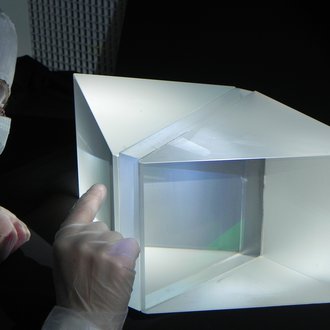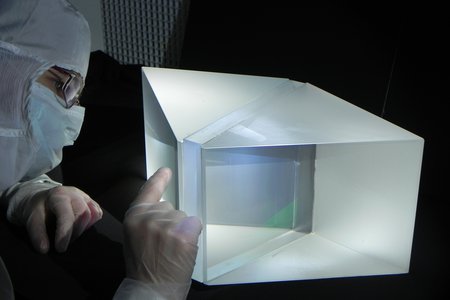Simultaneous light decomposition

An optics scientist from Thales SESO puts the finishing touches to one of PEPSI's six cross-dispersers.
Credit: Thales SESOLatest optics for the PEPSI spectrograph at the Large Binocular Telescope (LBT).
The PEPSI spectrograph, being developed and built at the Leibniz Institute for Astrophysics (AIP), will in the future enable astronomers to simultaneously obtain highly resolved spectra in the optical and near infrared light. This is made possible by the employment of special optical components called cross dispersers. The last of a total of six of these dispersers made by the French company Thales SESO has now arrived at the AIP labs for integration into the spectrograph.
Spectrographs are used to decompose white light, for instance the light of stars, into its individual colours. Dark lines appearing in a spectrum can result from the absorption of light by bound electrons in an atom, thus giving a fingerprint of the physical properties of a star and its surface chemistry. The phrase "a spectrum tells us more than a thousand images“ is very appropriate for modern stellar astrophysics.
With a resolution of only 0.002 nanometres – 2 trillionths of metres – the "Potsdam Echelle Polarimetric and Spectroscopic Instrument" (PEPSI) outperforms today’s spectrographs by a factor of five, running in parallel in the full optical and full infrared wavebands. The cross dispersers give this parallel coverage, as they decompose the light not according to its wavelength but rather, according to the geometrical direction which is perpendicular to the light dispersion of the grating. This allows for simultaneous observation of the individual spectra, providing access to all wavelengths at the same time.
The PEPSI cross dispersers are made of three components each: a prism which parallelizes the incoming light, a “volume phase holographic“ (VPH) grating plate which is a hologram in a gelatine layer illuminated by the light installed on two very precise plane-parallel glass plates of pure fused silica which catches the incident light. Finally, a second prism is located at the emission point, connected optically to the VPH grating plate.
After completion in 2013, PEPSI will be shipped to the Large Binocular Telescope on top of the 3200 metre high Mount Graham in Arizona to start science operations in 2014. After 10-years of construction and investments of about five million euro, PEPSI will then be the world’s largest and most powerful spectrograph of its kind, being able to observe magnetic fields of stars other than our Sun.
Images
An optics scientist from Thales SESO puts the finishing touches to one of PEPSI's six cross-dispersers.
Big screen size [1000 x 666, 50 KB]
Original size [3648 x 2432, 590 KB]



